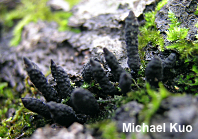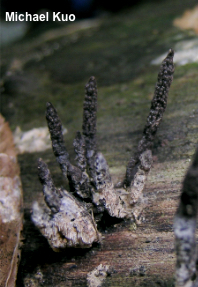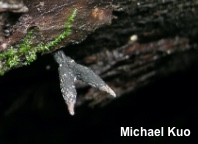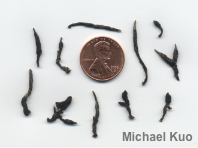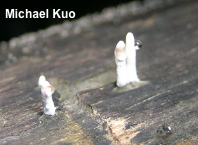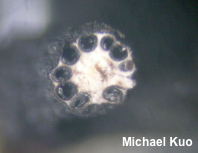Xylaria longiana (MushroomExpert.Com) (original) (raw)
Xylaria longiana
[ Ascomycota > Sordariomycetes > Xylariales > Xylariaceae > Xylaria . . . ]
by Michael Kuo
Xylaria longiana is a scrawny species of Xylaria that grows on deadwood, virtually indistinguishable from several similar species—although it is usually a bit smaller than Xylaria hypoxylon and Xylaria cornu-damae. More definitively, its spores are distinctive when compared to the spores of those species; they are substantially shorter (see details below), and feature a straight germ slit that extends nearly the full length of the spore.
The anamorphic stage of Xylaria longiana appears in spring in early summer, and features relatively smooth, whitish to pale grayish surfaces. Later in summer the fruiting bodies mature and become teleomorphs; at this point the surfaces become black and finely pimply.
Thanks to Anne Looker for documenting, collecting, and preserving Xylaria longiana for study; her collection is deposited in The Herbarium of Michael Kuo.
Description:
Ecology: Saprobic on decaying wood and bark of oaks; growing alone or gregariously; causing a soft rot; appearing from spring through fall; probably widely distributed east of the Rocky Mountains. The illustrated and described collections are from Illinois.
Fruiting Body: 6–30 mm tall; 1–3 mm thick; more or less cylindric (but occasionally irregular), with a pointed tip; usually single, but occasionally with fused bases; whitish to pale grayish and smooth in spring and early summer; in summer and fall becoming black with a roughened and pimply surface; base black and finely fuzzy; interior flesh white and very tough.
Odor: Not distinctive.
Microscopic Features: Spores 10–13 x 5–6 µm; subellipsoid to subfusiform; smooth; dark brown in water and in KOH; with a thin, pale germ slit that extends the length of the spore. Asci 8-spored.
REFERENCES: Rehm, 1904. (Saccardo, 1905; Chacko & Rogers, 1981; Rogers, 1986; Rogers, Miller & Vasilyeva, 2008.) Herb. Kuo 10290402, 10110906, 06161011, 07041901.
This site contains no information about the edibility or toxicity of mushrooms.
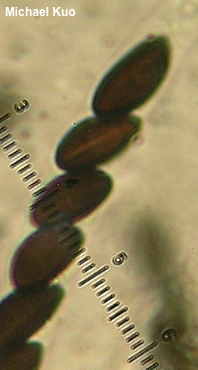
Spores
© MushroomExpert.Com
